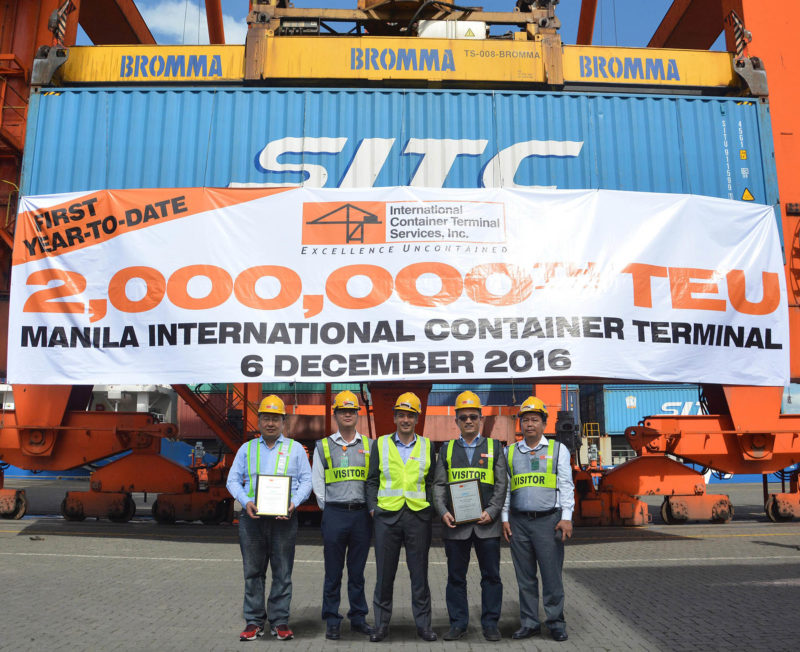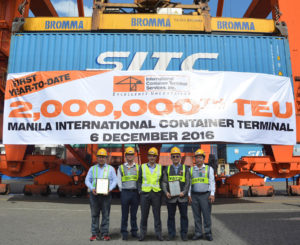

The Manila International Container Terminal (MICT) reached its first year-to-date 2-million twenty-foot equivalent unit (TEU) move last December.
The flagship operation of global port operator International Container Terminal Services, Inc. (ICTSI), MICT has an annual capacity of 2.75 million TEUs.
In a statement, ICTSI said the 2-millionth TEU container was offloaded from vessel SITC Osaka, operated by Chinese megaliner SITC Container Lines, and which originated from Ningbo in China.
SITC is a long-time MICT client with regular vessel calls to the Port of Manila.
MICT reached its first one million-TEU move in December 2002.
The two-million milestone also triggers a multi-billion peso capacity improvement commitment with the Philippine Ports Authority that requires ICTSI to commission five additional post-Panamax quay cranes along with corresponding yard equipment, and build at least another berth by 2019, according to the company.
A ceremony to commemorate the milestone was led by ICTSI senior vice president and Regional Head of Asia-Pacific and MICT Christian Gonzalez, and SITC Container Lines Philippines, Inc. general manager Qing Quan.
“Today represents a significant achievement for MICT as we continue with our mandate to provide the highest level of service to our clients and stakeholders, most especially to the Filipino people. As the gateway to the Philippine market, MICT consistently seeks to improve our operational efficiency to ensure fast and uninterrupted flow of trade in and out of the port,” Gonzalez said.
ICTSI said terminal utilization at the MICT has significantly improved since the completion of Yard 7 late in November 2015. Yard 7, which is part of MICT’s P5-billion expansion project, increased the terminal’s capacity by 18% from 2.5 million to 2.75 million TEUs.
Key to achieving the two-million TEU milestone was the rollout of the Terminal Appointment Booking System (TABS), an online container booking platform, in October 2015, which ICTSI said significantly improved and optimized the flow of trucks in and out of the terminal.
“The construction of Yard 7 and the implementation of TABS last year gave us the flexibility and efficiency we need to perform optimally. We have more projects in the pipeline like the revival of the rail line which will link MICT with Laguna Gateway Inland Container Terminal,” Gonzalez said.
Aside from establishing an intermodal link between its Manila and Laguna terminals, ICTSI also submitted a proposal to the Department of Transportation to build the Cavite Gateway Terminal (CGT), a US$30 million common-user barge and roll on–roll off terminal in Tanza, Cavite. The 115,000-TEU facility, which will be built in a six-hectare property, will also be directly linked with MICT. The transhipment of cargo from MICT to CGT and vice-versa will serve the dynamic economic activity of Cavite, and lessen the number of truck trips in Manila by approximately 140,000 annually, the company said.
“All of these projects are aimed at maximizing the efficiency of our operation and ensuring uninterrupted movement in the supply chain regardless of the season or fluctuation in demand. We continue to work with our stakeholders and partners in the government in formulating and implementing strategies for the benefit of the industry and the national economy,” said Gonzalez.




